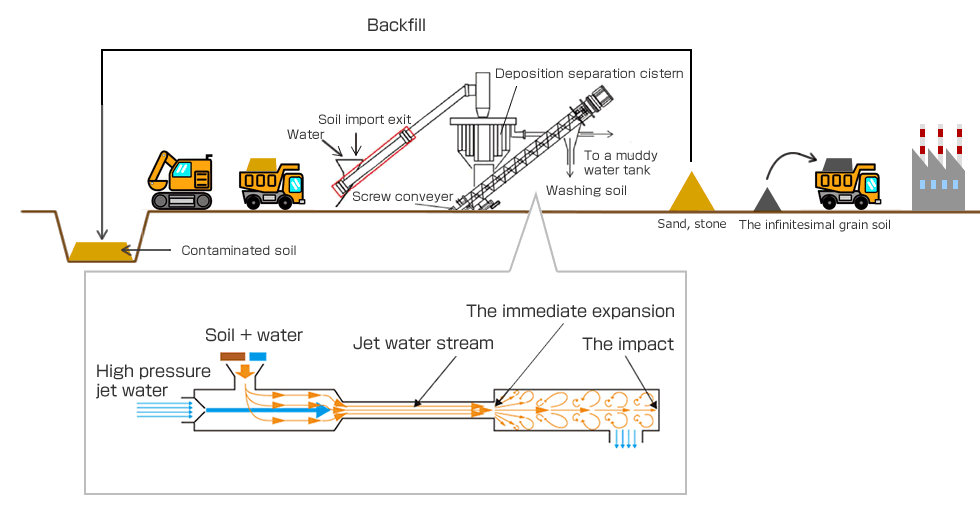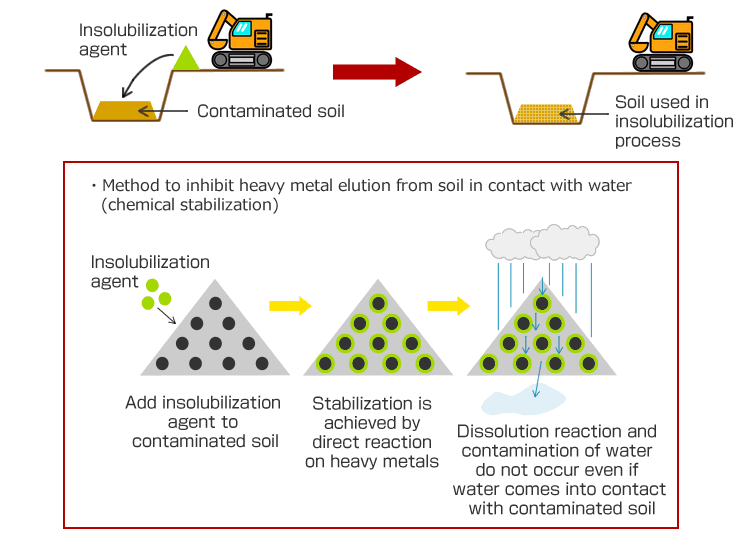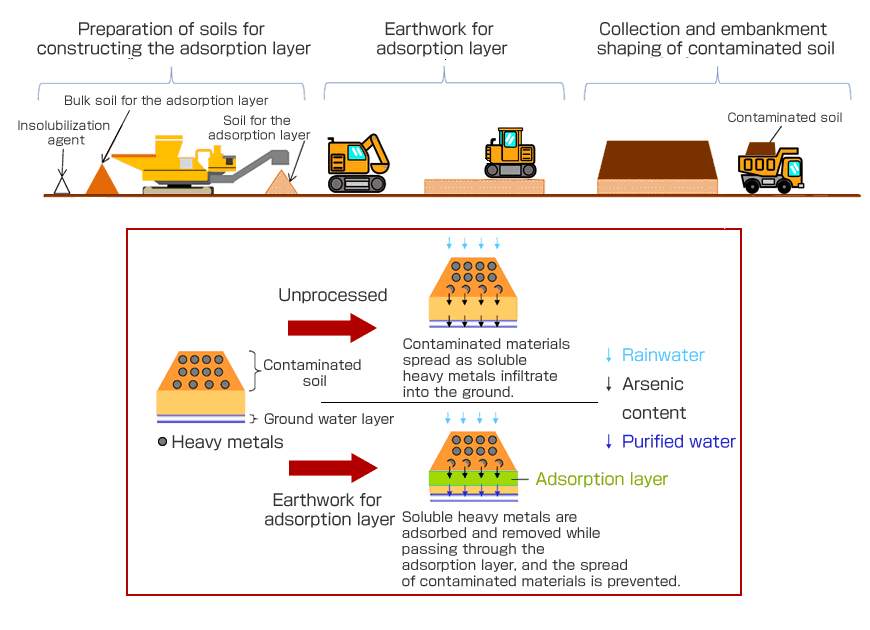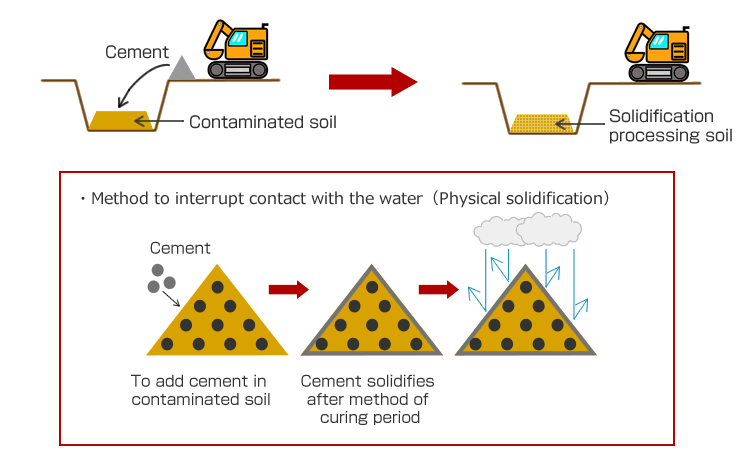What are soil contamination countermeasures?
AMEC is calling for “human- and earth-friendly treatment” for soil contamination. AMEC thinks this a real solution. Note: The paper entitled “Development of materials for removing heavy metals such as arsenic contained in water or soil,” was awarded the Technology Excellence Award in 2010 by the National Institute of Advanced Industrial Science and Technology in Shikoku.
- AMEC can propose a great variety of solutions by combining treatment techniques such as insolubilization, adsorption, and washing with our unique materials. We will propose the most suitable treatment method depending on the level of contamination and on-site conditions.
- While the “Soil Contamination Countermeasures Act” was revised to promote on-site measures, we are proposing an “insolubilization method and adsorption layer method of construction” for dispersion prevention and a “washing method the complete removal of pollutants” as on-site measures.
- We support the planning of measures and verification tests for soils contaminated with heavy metals and oil, and thus we are able to achieve human- and eco-friendly measures for purification without impacting the environment.
Specific examples of AMEC’s solutions
Our products and construction methods are summarized according to the contamination conditions.

- Target / Amount:
- Vacant lot 800m³
- Pollutant concentration:
- Fluorine (F) 1.1mg/L
- Situation:
- Contamination was detected during a real estate contract for a new commercial facility.
- Construction method and materials:
- Washing method, SoiCle
- Reasons why AMEC was chosen:
- Cancellation of the area designation was possible. On-site short-term treatment was possible.
- Successful results:
- Adopted by the urban development plan

- Target / Amount:
- Dredged soil 1,000m³
- Pollutant concentration:
- Arsenic (As) 0.03mg/L
- Situation:
- Contamination was detected in the soil from an irrigation canal construction site near rice fields.
- Construction method and materials:
- Insolubilization, CAMZ-S
- Reasons why AMEC was chosen:
- On-site measures did not influence the surrounding area.
- Successful results:
- Adopted by the farm road development plan

- Target / Amount:
- Old factory site 2,000m³
- Pollutant concentration:
- Arsenic (As) 0.024mg/L
- Situation:
- Contamination was detected in the preliminary study of an old factory site for sales contract.
- Construction method and materials:
- Insolubilization, CAPA-CT
- Reasons why AMEC was chosen:
- Composition amount could be precisely determined depending on the elution concentration.
- Successful results:
- Adopted by the land reuse plan

- Target / Amount:
- Mud excavated from tunnel ≧ 10,000m³
- Pollutant concentration:
- Arsenic (As) 0.068mg/L
- Situation:
- Naturally occurring contamination was detected in soil excavated during the construction of a tunnel.
- Construction method and materials:
- Adsorption layer construction method, CAPA-CT
- Reasons why AMEC was chosen:
- Time to implement countermeasures could be reduced. Environmental load could be minimized. Diversion to soil for embankment was possible.
- Successful results:
- Adopted in the countermeasures for excavated mud in the East Japan district

- Target / Amount:
- Mud excavated from tunnel ≧ 100,000m³
- Pollutant concentration:
- Arsenic (As), 0.018mg/L Selenium (Se) , 0.012mg/L Boron (B) , 1.3mg/L
- Situation:
- Naturally derived complex contamination was detected in the soil excavated during the construction of a large-scale tunnel.
- Construction method and materials:
- Adsorption layer construction method, CAPA-CT
- Reasons why AMEC was chosen:
- A single material could be used to handle combined contamination. Time to implement countermeasures could be reduced. Environmental load could be minimized.
- Successful results:
- Adopted in the countermeasures for excavated mud in the West Japan district
- ※ Above pictures are sample photos.
Construction methods
~ Comparison of countermeasures ~
The characteristics of soil contamination countermeasures are presented below. AMEC always proposes the most suitable method, while weighing not only costs and safety but also impact to the environment.
These methods of construction are often used in AMEC’s solutions.
AMEC’s proposal of pollution countermeasures begins with its own thorough research on the conditions of contaminated water and soil.
After having properly grasped the contamination conditions, we start by finding good and effective countermeasures through comparison with the previously accumulated data.
We can propose just enough rational measures simply because we thoroughly understand the contamination conditions.
- Summary:
- Separation of small components containing heavy metals by washing the contaminated soil.
- Major machinery and equipment:
- Backhoe
Cleaning equipment
Washing water treatment facility - Remarks:
- Low environmental load treatment is achieved using a small water washing machine with excellent washing efficiency.
With its compact design unlike a large washing plant, it is also appropriate for use in a small site. Securing and treatment of washing water is separately required. - Economic potential:
- △
- Workability:
- △
- Stability:
- ◯
- Environmental load:
- ◯
- Zone classification after treatment:
- Delisted
- Summary:
- Heavy metals are chemically solidified and stabilized by adding and mixing insolubilization materials.
Recycling is enabled after the elution concentration is suppressed to less than the standard - Major machinery and equipment:
- Backhoe
Stabilizer
Self-propelled soil improvement machine - Remarks:
- The risk of secondary pollution is low, directly acting on pollutant and achieving chemical stabilization.
In addition, recycling is possible. Special processes and an effluent treatment facility are not required, and the treatment method has advanced economic potential, stability, and workability. - Economic potential:
- ◎
- Workability:
- ◯
- Stability:
- ◎
- Environmental load:
- ◎
- Zone classification after treatment:
- Notification is required in the event of changes to characteristics.
- Summary:
- Adsorption materials are laid and contaminated soil is piled on top.
A large amount of contaminated soil is treated in a short period, and the proliferation of heavy metals is prevented. - Major machinery and equipment:
- Backhoe
Stabilizer
Self-propelled soil improvement machine - Remarks:
- Proliferation of soluble heavy metals from the contaminated soil is effectively prevented.
Workability is improved using the insolubilization method. This method is the most suitable for countermeasures associated with tunnel construction involving a large quantity of contaminated soil. - Economic potential:
- ◎
- Workability:
- ◎
- Stability:
- ◎
- Environmental load:
- ◎
- Zone classification after treatment:
- Notification is required in the event of changes to characteristics.
Construction methods ~ Comparison of countermeasures ~
- Summary:
- Contaminated soil is excavated and conducted to a treatment site. Replacing with clean soil is necessary.
- Major machinery and equipment:
- Backhoe
Transport truck - Remarks:
- Treatment cost is high, and a considerable economical load is imposed on treatment sites with limited area.
In addition, there are risks of proliferation and illegal dumping during transportation. - Economic potential:
- ×
- Workability:
- ◯
- Stability:
- ◎
- Environmental load:
- ×
- Zone classification after treatment:
- Delisted
- Summary:
- Seepage control sheet is laid.
A separate effluent treatment plant is necessary as a leachate countermeasure. - Major machinery and equipment:
- Backhoe
Seepage control sheet welder
Effluent treatment facility - Remarks:
- Risk of the seepage of concentrated contaminated water associated with damage to the seepage control sheet.
A separate effluent treatment facility is required. - Economic potential:
- ×
- Workability:
- ×
- Stability:
- △
- Environmental load:
- △
- Zone classification after treatment:
- Notification is required in the event of changes to characteristics.
- Summary:
- Contact with water is prevented using cement.
- Major machinery and equipment:
- Backhoe
Stabilizer
Self-propelled soil improvement machine - Remarks:
- Risk of repeated elution of pollutant by age-related degradation associated with physical solidification.
- Economic potential:
- ◯
- Workability:
- △
- Stability:
- ×
- Environmental load:
- △
- Zone classification after treatment:
- Notification is required in the event of changes to characteristics.
Steps toward the solution of the problem
AMEC’s sales representatives and engineers brainstorm in consultation with the customer until a satisfactory solution is reached.
- 1Emergence of a problem
- Do not hesitate to contact AMEC when in urgent need of pollution countermeasures.
- 2Diagnosis
- A sales representative and an engineer are specislly assigned to each cutomer;they are responsible for helping thecustomer to solve the problem.
- 3Vaidation
- They examine the on-site and surrounding environment and take note of the customer's problems.
- 4Planning
- AMEC's engineers work together to find the best suitable solution and draw up a plan.
- 5Solution to the problem
- We make every effort to not only clean up the pollution but also ease the customer's concerns.






